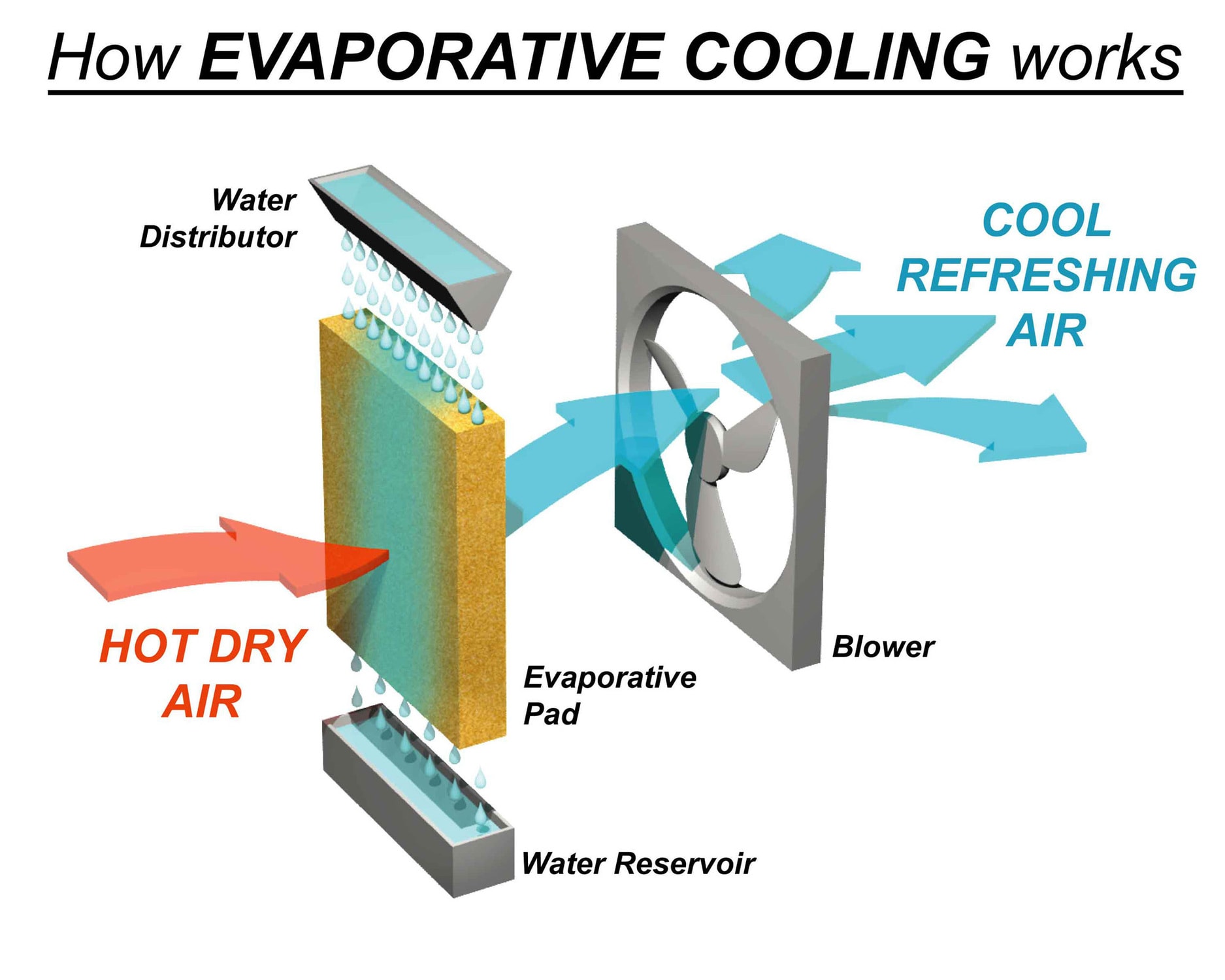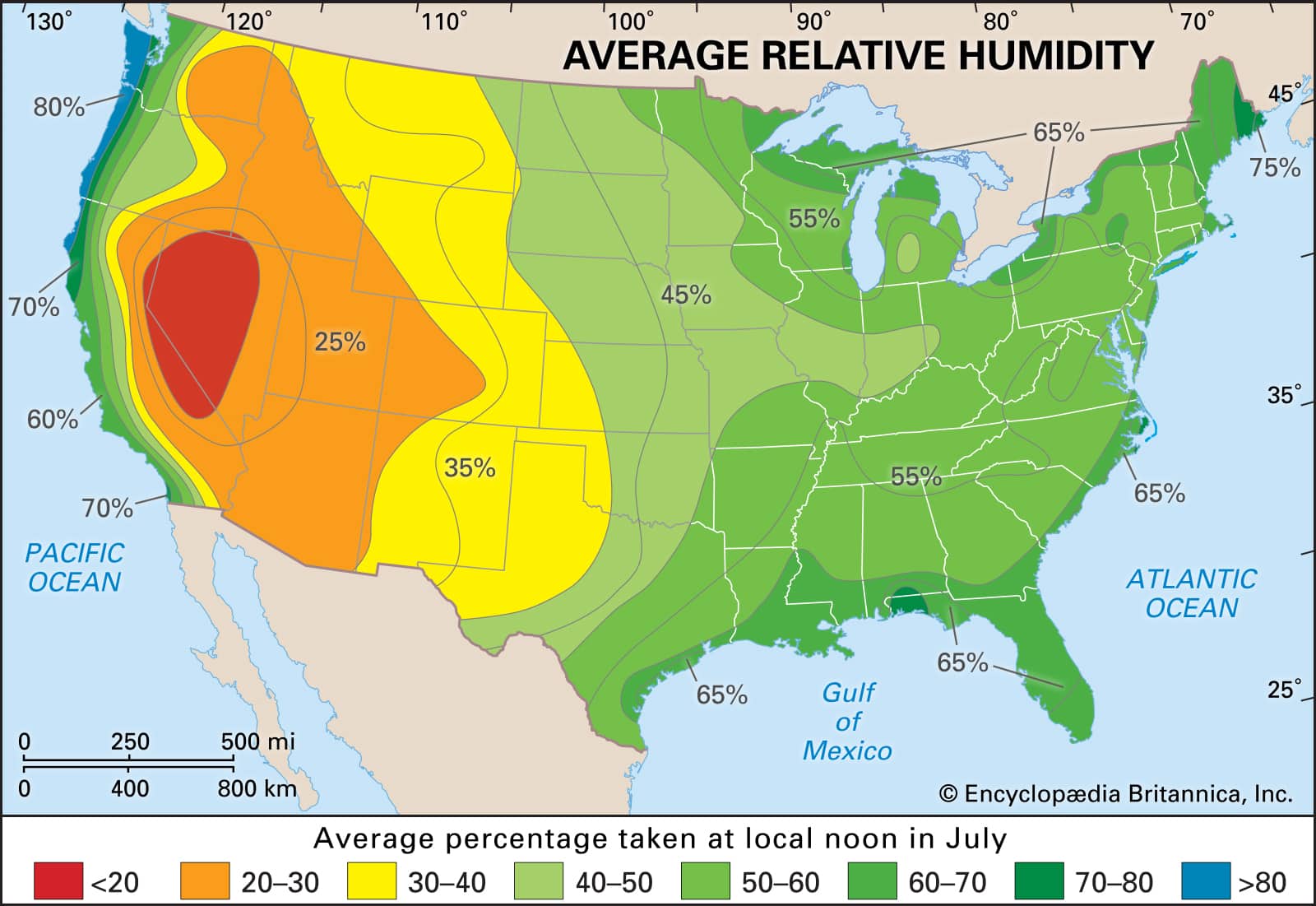Evaporative coolers, also known as swamp coolers in the more humid areas of the USA, are affordable and efficient cooling solutions that won’t make you weep when the electricity bill comes in.
I know evaporation, you know evaporation, everybody knows evaporation, and it’s this process that evaporative coolers use to change the local temperature.
We’ve known for centuries that water and other liquids make the surrounding air cooler when they turn into gases and diffuse into the local environment.

They don’t work as hard as a standard air conditioning unit though, they only work to an extent. There are a lot of similarities between how evaporative coolers work and how sweating works on your body. Sure, sweating helps to cool the body, but it only works up to a certain point.
Let’s get into the details of how evaporative coolers work, when using them is most efficient, and whether you should get one or not.
How They Work
We need to understand how these evaporative coolers work before we get into the specifics of how evaporative efficiency works. When you buy an evaporative cooler, you’re getting a machine that uses a fan to pull in hot and dry air and eject cold air, which speeds up the evaporation process by increasing the humidity of the area.

These coolers get the water from a pad that’s integrated into their design, which has been maximized for surface area to facilitate more evaporation in a shorter time frame. The fan targets these pads, introducing warm air to the water in the pads, causing them to evaporate and turn into cooling gas molecules.
Of course, the efficacy of this process will depend on the natural humidity of your home climate. If you’re in a dry area, the humid air created by an evaporative cooler will be even more effective since it can bring comfort and relieve other problems caused by dryness, such as dryness of the nasal passages.
To answer the question of where the evaporative cooler can be most effective, we need to explain what the cooler efficiency chart is.
The Efficiency Chart
First, you need to understand that, like temperature, humidity can and will change from day to day. That’s why it’s best to have a whole chart that can be used to cover all possible humidity levels and temperatures possible.
That’s the evaporative cooler humidity chart. It consists of a vertical Air Temperature Y-axis and a horizontal Relative Humidity X-axis that’s communicated in percentage. Air temperature starts at 75 and stops at 125 while humidity is usually covered from around 2% to 80%.

Where these values intersect, you have the meat of the chart with the air supply temperature figures, the figures you can expect from your evaporative cooler when it’s operational. The span of possible temperatures here differs depending on the air temperature and the humidity. For example, 2% to 20% humidity can produce anywhere from 54 to 96 in supply temperature depending on the air temperature, while 75% humidity will never see temperatures below 70.
These charts are intended to find the sweet spot for evaporative coolers, where they operate at maximum efficiency have the most appreciable effect on their environment. No matter the air temperature or relative humidity, this will always be between 70 and 75.
More On Air Temperature
Let us explain exactly what we mean when we say air temperature and what this means for evaporative coolers. First, your assumptions are correct, it is simply how hot or cold the air feels to your garden variety thermometer. What’s more important are the causes and implications of these temperature figures.
As we described above, air temperature is only half of the equation, but taking the temperature while isolating the humidity isn’t easy. Two means of testing air temperature are applied – dry bulb and wet bulb. Dry bulb temperature is the temperature without factoring in humidity, and the more important one for these charts.
Wet, on the other hand, involved wrapping the thermometer in wet fabric and taking the lowered temperature. The lower this temperature, the lesser the humidity and so the more evaporation is taking place. That is the ideal condition of an evaporative cooler.
More on Relative Humidity
Expressed in percentages, relative humidity is how much water currently sits in the air around you. It’s often important for those who have sinus or skin conditions, or for sensitive item storage, like cigars, which need to be stored at certain humidity levels.
Hot air holds more water than cold air, which is why colder days feel more humid since the air is saturated with what little water it can hold.

The relative humidity is where the humidity has been considered in the context of temperature since the two are often linked.
Relative humidity measures the moisture in the air and then compares it to the maximum water amount that the corresponding air temperatures can hold.
This means that relative humidity is the measurement of the current saturation of the air around you.
Yes, this is also why a high relative humidity in summer is so feared because the water can’t evaporate into the air which makes things difficult for those who break a sweat.
How Does This Help?
By finding the measurements of your air temperature and the relative humidity nearby, you’ll be able to find out the optimal temperature to run your evaporative cooler at. As said, the 70-75 range is best, though getting what you can out of your cooler is fine if you’re desperate for some temperature relief. This brings us to the next question you should be asking…
Is It Worth Your Time?
With the above information in mind, you’ll need to decide if getting an evaporative cooler is worth your time and money if you haven’t already bought one. Relying on this type of cooling isn’t viable for everybody. Different areas have temperatures and humidity levels that are inconsistent across long periods, making relying on them a poor solution to your troubles.
Get the averages for temperatures and humidity for each of the four seasons. That way, you have some generalized numbers to work with when determining what you can expect. Spring and summer tend to be more important for those of you who just want to keep the heat at bay, of course.
If you want to do your due diligence, you should be able to find meteorological data of your area’s temperature and humidity throughout the years. That way you can plan and see if any great shifts are expected to occur in years and decades.
Since most of our advice is for those Stateside, you should know that the more west you are, the higher the chance that you’ll get good use out of your evaporative cooler. In the easy, these coolers are used outdoors more than indoors, to avoid an interior humidity increase that’ll get uncomfortable. Instead, outdoor parties and occasions are the primary use of evaporative coolers, where they make the surrounding area more comfortable and help avoid people getting clammy.

Airflow Tips
Since your evaporative cooler is going to promote colder air in your home, chances are that you want that air to spread far and wide. That way more of your home or backyard is cooled, getting you more performance from your initial investment in these coolers.
The best tip we can give you is to maintain a fresh airflow to and past your cooler once it has been set up. This often means keeping a window open, maybe a door if you can do so safely, or a garage door if the cooler has been placed there. You know your home more than we do, so you’ll know your ways of increasing the cycle of fresh air into your home and the expulsion of used air.
There are pre-existing factors that can help a house clear more airflow. Ventilation ducts are probably the most common since they directly facilitate the transfer of air into the home. A more unconventional approach would be the use of many household plants that recycle the oxygen in your home, clearing that space for new air to enter the home.
We’d also avoid drying clean laundry inside, and keeping other damp items around since that will raise the moisture level of your home and affect any evaporative coolers you have on the go.
Other Related Guides
Here is some other content that might interest you:
